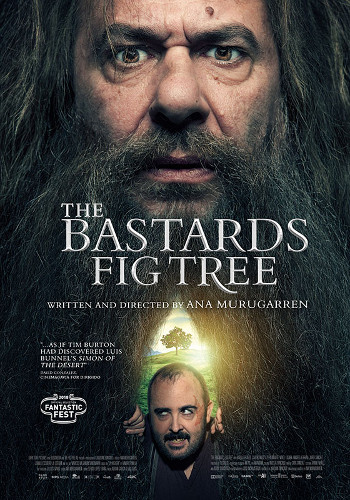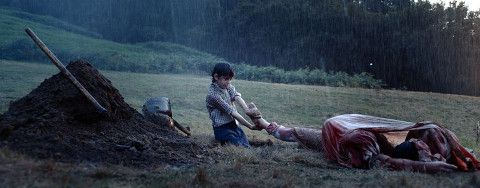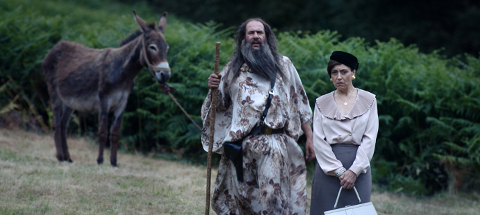The Bastards' Fig Tree (2017)
Directed by: Ana Murugarren
Written by: Ana Murugarren
Starring: Carlos Areces, Karra Elejalde, Mikel Losada, Pepa Aniorte
AKA LA HOGUERA DE LOS BASTARDOS
Spain
AVAILABLE ON REGION 1 AMAZON PRIME: NOW, from DARK STAR PICTURES
RUNNING TIME: 103 mins
REVIEWED BY: Dr Lenera, Official HCF Critic
Rogello is a member of a Fascist death squad operating during the Spanish Civil War. He seems to have no issue with rounding up people and shooting them. One night though, his latest “cleansing” job results in a ten year old boy locking eyes with him, just before he takes away and executes his father and his older brother. Plagued with guilt and fear that, by the time he reaches 16 [adulthood in Spain], the boy will kill him, Rogello begins to spend more and more time by the grave of the boy’s father and brother, tending to and guarding the fig tree that the boy has planted over the burial site.…
It’s more easy to be surprised and to go in blind when you’re reviewing a digital screener than a film at the cinema or a release on disc. With the latter two, one is more likely to have heard of the film at hand, but digital screeners, at least in my experience with them, tend more to be of movies that have not been picked up by my radar. I hadn’t heard of The Bastards’ Fig Tree at all, but the title attracted me, and I then opted to watch it without my usual preliminary check on the IMDB to get some idea of what the thing was about. I guess I expected another Spanish horror film, which was not at all an unattractive proposition, but Horror Cult Films is roughly 60% horror and 40% everything else, reflecting the tastes of the people who write for it [I couldn’t watch horror all the time, it would drive me mad], and it soon became apparent that The Bastards’ Fig Tree wasn’t horror at all, at least not in the conventional sense. But I was immediately hooked by this unusual tale of human evil, faith and redemption. While I was occasionally reminded of films as diverse as The Song Of Bernadette, Simon Of The Desert and even [don’t laugh] Greyfriars Bobby, and you could possibly place it with other Spanish offerings which use the Spanish Civil War as a backdrop to a fable-like story like The Spirit Of The Beehive and Pan’s Labyrinth, it really isn’t much like anything else out there at the moment. And if you’re put off by my mentioning of the words “faith” and “redemption” please don’t be. Yes, there is a Christian element in the film, but, even if others do, the main character never seems to actually ‘believe’ and maintains a cynical attitude to religion all the way through, while his redemption is handled with a distinct lack of sentimentality and, while one can understand his inner torment, you’re often asked to consider if he could be a little mad.
The camera tracking over fields and forestry before following a tiny moving vehicle on a road beneath then introduces us to our ruthless death squad on one of their “cleansing” missions. Informers, usually with vested interests, give them certain names, after which they go in the middle of the night to round up suspected Republican ‘reds’ (if they happen to own nice properties or attractive land it’s a bonus), bundle them into their car and shoot them out in the forest. The especially cruel leader is Pedro Alberto Echábarri, and our Rogello is one of his best aides. There’s a rule that states that they cannot kill children, but one guesses that, if they weren’t forbidden to do this, they’d be murdering loads of kids too. They appear to firmly believe that their cause is just, but are rather enjoying what they’re doing too. I thought that the film was very brave in showing its supposed hero as a person almost beneath contempt and certainly not someone to root for. In fact, if I’d read a synopsis before I’d began to watch, I’d have gone as far as to say it was foolhardy. How on earth was the film going to then get us to sympathise with this guy or at least properly engage us with his feelings and penitence? In any case, being completely ignorant of anything that was going to happen, it was uncomfortable yet morbidly fascinating just watching these totally heartless scumbags going about their business, then behaving more like actual human beings, if somewhat arrogant ones, in between murderous missions. While Goodfellas and other films have depicted this type of thing, it’s still strange seeing them sitting down to a considerable dinner cooked by Cipriana the wife of the Mayor and owner of the house they’re currently staying after blowing a few brains out, while I was trying to fathom why they are the way they are, to see some traces of genuine humanity underneath the repulsive exterior.
Well, Rogello quickly becomes seriously affected by a stare from a small boy whose father and brother he then goes on to murder. He feigns illness so he doesn’t have to go “hunting” with the gang, then is drawn more and more to where the boy has managed to bury his dad and sibling all by himself. He’s encouraged by Cipraina, who, even though her husband has gone over to the side of the Fascists, retains loyalty to the other side. She thinks that Rogello has had a meeting with “our lady”, but Rogello dismisses any Christian element, something he’ll go on to do throughout. As Rogello starts to look after the fig tree sapling that the boy planted on the grave, and his nights out there turn into what is getting to be more like permanent residence, he and Cipriani form a close bond, yet there’s no affair which is what I was expecting. Another increasingly important person in Rogello’s odd life is the shifty Ermo. In a way the person who started all this due to providing the information that led to this particular double killing, he’s soon going to own the place when its owners are going to be kicked out. Ermo keeps on trespassing where he shouldn’t and has somehow been convinced that the grave contains lots of money, but you think that some kind of friendship is eventually going to form – only it doesn’t really happen. The scenes between the two still have an odd but pleasant quirky quality and even produce the odd wry laugh, but it’s notable how Rogello remains edgy and rude, and rarely seems to be at peace. At one point he even tries to return to his old job, but events set in motion by him attempting to help the boy have a better life lead to him remaining. The boy is a strange, silent figure who shows up every now and again to prod Rogello into maintaining the same direction. I kind of wished I knew more about this character, something I could say for some of the others too, but then they seem to be intended more as symbolic archetypes more than anything else.
Because Rogello doesn’t move even as the years pass and the site becomes a religious attraction despite Rogello’s efforts to prevent it, we spend an enormous amount of time in the same place, but I doubt you’ll be bored if you’ve decided by now if this very off-the-beaten-track movie appeals or not. A key ingredient in keeping me interested was the simply fantastic performance of Karra Elejalde. Probably most familiar to British viewers from Timecrimes [though if you’re impressed by him in this film I recommend that you go and check him out in the grim but excellent la madre muerta aka Dead Mother if you can find it], he manages to portray his character’s journey with conviction and plausibility even if one may have the nagging feeling that we’re not being allowed to get too close to him. Sometimes scenes which seem like they will provide more insight into his behaviour and thought processes end rather suddenly, such as when he’s visited by an ex-girlfriend and we think that he’s going to tell her why he never opened any of her letters yet still kept them – and then we cut to the next scene. Rogello remains quite enigmatic, yet this appears to have been intentional. Talking of women, there’s a funny scene [possibly inspired by the bit from The Wicker Man which we all probably enjoyed most as teenage boys] where Echábarri, who’s continually unhappy about where Rogello has taken up residence and is always trying to find ways to get him to leave, tries to entice Rogello away with a prostitute. He’s able to resist her distant seduction routine but can’t resist applying some hand relief – and then Ermo turns up at the most awkward time as usual.
The grim tone of the first third largely dissipates, partly replaced by a more picaresque approach. Of course the whole story is somewhat absurdist in nature anyway, but writer/director Ana Murugarren, adapting a novel by Ramiro Pinilla, manages quite a delicate balancing act in terms of tone, never letting the lighter moments turn things into an out and out comedy [though I could have done without Grieg’s In The Hall Of The Mountain King, you’ll know it when you hear it]. Quite a bit of symbolism seems to be present too, most notably in connection with the fig tree itself, its growth maybe paralleling the emergence of a country from soil fertilised by the dead bodies of so many people, while the latter stages throw up questions concerning the legacy of the Spanish Civil War and how best to honour its victims – and by extension reminding us that we should never forget the past and remember that it still has considerable lessons to teach us. Yet Murugarren makes sure that all this stuff is just hanging around in the background, more hinted at then explicitly stated, so one can easily ignore it if one wants to, and concentrate more on, say, the look of the piece, which is often quite artful, such as the many night time shots where golden light illuminates certain areas of the screen, the flame of humanity still burning even when virtually drowning in darkness and evil. Cinematographer Josu Inchaustegui does a fine job throughout, while the music score, despite being credited to two composers – Adrian Garcia de los Ojos and Aitzol Saratxaga – has two nice themes but is very sparsely spotted throughout the picture.
In the end The Bastards’ Fig Tree is most definitely not for all tastes, and despite what we witness its climax lacks the power it ought to have even if an end credits scene [they’re everywhere these days] partly rectifies that. I could have personally done with being taken closer to the characters a bit, to be given more of a chance to understand them, but Murugarren, a former editor who, on the basis of this her second directorial effort unless you count a TV movie, is a filmmaker of considerable interest with her own unique view of things and seemingly a particular fascination with the Spanish Civil War, clearly intended her film to have more of the feel of a fable – and that’s okay because it still works pretty well as one. Unique, droll yet also really rather inspirational, it’s a minor gem that deserves a far wider release than it currently has.







Be the first to comment